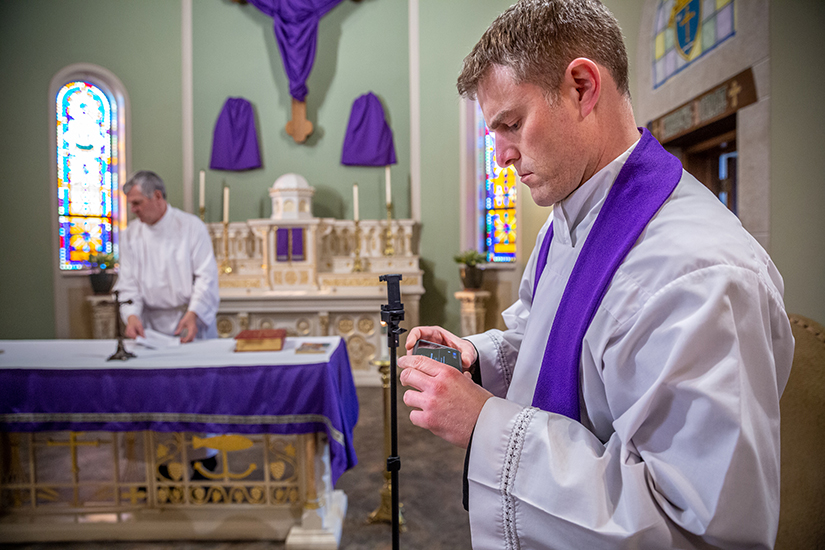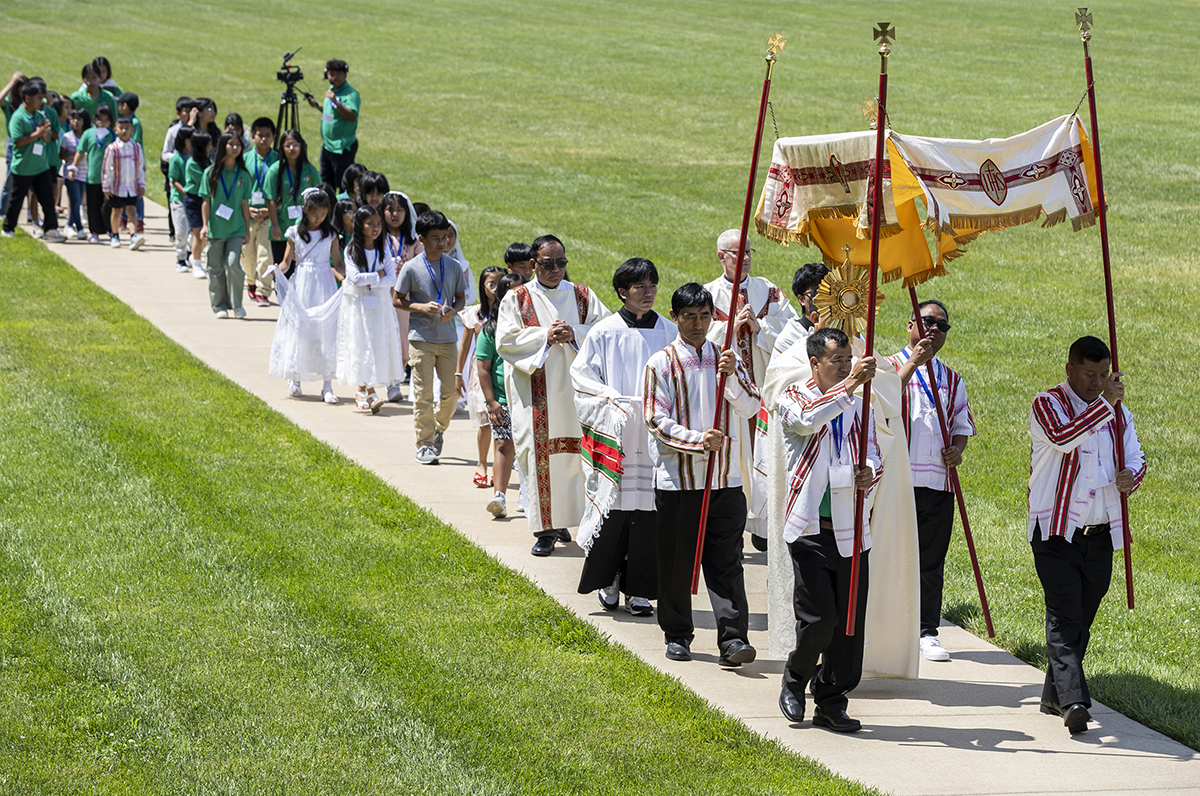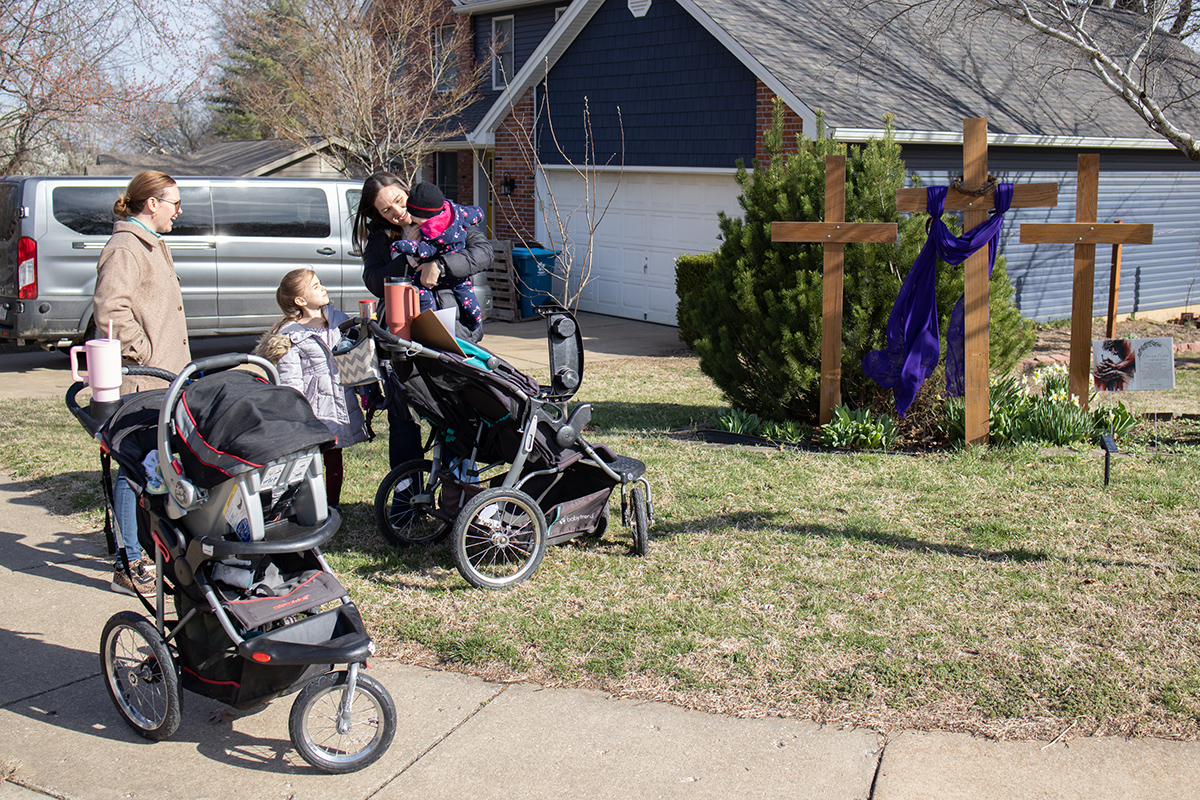Livestreaming of Masses ‘different,’ but beneficial

Online options help priests share Mass, stay connected
A priest offers Mass to worship God, and the people are sanctified by that worship, even if they aren’t physically present.

“The priests should still be offering Masses because it is our ministry to first and foremost worship God,” said Father Thomas Keller, pastor of Assumption Parish in south St. Louis County. “We pray that through participation through livestream or people praying at home at that same hour or whatever they’re doing, God is continuing to show His mercy and to confer grace to those who cry out for it.”

Livestreamed and televised options for Holy Mass and other services are available in the Archdiocese of St. Louis. Due to the projected spread of the COVID-19 coronavirus and following recommendations from health and government officials, Archbishop Robert J. Carlson suspended all public liturgies, including for Holy Week and beyond.
Modern technology allows people to witness the celebration of Mass and make a spiritual communion at a time when we cannot receive Him in sacramental Communion. People are encouraged to check with their parishes and visit www.archstl.org/coronavirus for livestreaming options.
Archbishop Robert J. Carlson will continue celebrating Masses livestreamed from the Cathedral Basilica of Saint Louis (www.cathedralstl.org) when he is the celebrant. “It is important that given these challenging times that we use available technology to be in touch (with) our Catholic people,” he explained.
Auxiliary Bishop Mark S. Rivituso celebrated a Mass that was livestreamed March 22 at St. Michael Parish in Shrewsbury and was scheduled to do so again there March 29.
He said that initially celebrating Mass without a congregation was “certainly a different experience. I enjoy the direct participation of the assembly at Mass.”
However, Bishop Rivituso said, he valued livestreaming the Mass, “for it is a way I can be visible and stay connected to the faithful of the archdiocese. After livestreaming the Masses, I have heard from the faithful their appreciation to continue to participate in the Mass and the benefit of making a spiritual communion.”
He said it is also good to hear from the faithful that they were grateful for the homilies, and they “even thought my sense of humor shared within them was funny. I appreciate the faithful being so gracious and charitable especially in regard to my humor.”
Priests in the archdiocese of St. Louis continue to celebrate Masses “sine populo” or without a congregation since public Masses have been suspended as a way to slow the COVID-19 coronavirus outbreak.
Father Timothy Foy is livestreaming the Masses he celebrates at St. John the Baptist (Gildehaus) in Villa Ridge, where he’s pastor. He’s getting the hang of using his phone to record and post the Masses on Facebook.
The parish mission statement is “We, the parish community of St. John the Baptist Gildehaus are called by baptism to continue Christ’s mission through education, example and service. We are nourished by Word, Worship and Sacrament. We dedicate ourselves to minister through our time, talent and treasure.”
Some of that is hard to accomplish right now, with gatherings halted almost everywhere and people staying inside their homes, but Father Foy insists that people still are nourished by the Mass. That’s because he’s praying for the faithful and they’re still receiving graces. “The faithful, while they can’t be physically present, there’s still a spiritual communion,” he said.

For people who want to go to Mass, there’s a sacrifice of obedience in accepting the limitations, he said. And it may help them to choose to make a spiritual communion, which is defined by St. Thomas Aquinas as “an ardent desire to receive Jesus in the most holy sacrament and lovingly embrace Him” at a time or in circumstances when we cannot receive Him in sacramental Communion. It’s a way, through prayer, of being as united as possible with the Church’s prayer.
Father Foy is pleased that technology allows people of his parish to use Facebook to follow the Masses he celebrates. “I’m learning. I had phone issues, and it cut out once at the beginning of the eucharistic prayer. But I’ve had good feedback. People are supportive and appreciative.”
As a priest it’s important for him to celebrate Mass “to keep a closeness and intimacy with the Lord.”
Livestreaming the Mass, he said, “keeps me connected with the parish.”
Assumption Parish in south St. Louis County kept the schedule of Masses at their regular times. Parishioners who want to maintain a normal prayer schedule at home are asked to link to the livestream at assumptionstl.org to participate in Masses, the Stations of the Cross and a Rosary recitation at noon.
Father Keller said a livestream camera was installed a few years ago as an Eagle Scout project by a parishioner, and the parish’s Masses already had a following among shut-ins. “We already had ‘congregations’ (online) at those Masses,” Father Keller said.
The parish is continuing to post messages on social media to let people know about the livestreamed Masses.
“While we’re hoping the lay faithful are keeping the discipline of prayer in their lives, it’s important for us priests to keep that discipline and pastoral zeal in our lives during an unusual situation,” he said. “My associate pastor and I decided it was best to keep offering Masses and make ourselves available even if it’s not in a face-to-face way.”
He’s received much positive feedback and thanks for the livestream Masses.
Alternative ways of offering the Sacrament of Confession – such as offering it outdoors – are also being discussed. This would eliminate the need to touch door handles or kneelers.
Prayers to avert an epidemic were livestreamed from the cathedral basilica and offered in a number of other parishes on March 19, the feast of St. Joseph.
At All Saints in St. Peters, Father Don Wester also received positive feedback. Everyone’s welcome to connect on the parish’s Facebook page, he said. “We had somebody connected from California. and we’ve had somebody from Germany. It’s really cool how it’s connecting people from all over the place.”
He appreciates seeing people’s responses after Mass. “People are answering prayers by typing them in. It’s a connection with people.”
A few issues, such as an echo in church, cropped up initially, but it’s proceeding smoothly since then. “So far, so good,” Father Wester said.
It’s important to stay connected with people, he said. Even without the connection, the reason to celebrate the Mass is to pray in union with the whole Church.
On the parish Facebook page, Father Wester wrote that abstaining from meat in Lent doesn’t seem like a big deal now that people can’t be in a physical presence with each other.
For a list of some of the livestreamed Masses in the archdiocese, visit www.archstl.org/live-streamed-and-televised-masses
For more information on the Archdiocese of St. Louis’ response to the COVID-19 outbreak, visit www.archstl.org/coronavirus
>> Current directive regarding Communion
Holy Communion may be administered by clergy and Extraordinary Ministers of Holy Communion to those who are seriously ill or in danger of death, only. All ministers of Holy Communion are to follow proper protocols for handwashing and the use of masks or other protective coverings.
St. Thomas Aquinas described spiritual communion as “an ardent desire to receive Jesus in the most holy sacrament and lovingly embrace Him” at a time or in circumstances when we cannot receive Him in sacramental Communion.
In the encyclical “Ecclesia de Eucharistia” (“A Eucharistic Church”), St. Pope John Paul II wrote that spiritual communion “has been a wonderful part of Catholic life for centuries and recommended by saints who were masters of the spiritual life.”
It doesn’t matter when or where you are, as long as you practice the devotion with “renewed faith, reverence, humility and in complete trust in the goodness of the Divine Redeemer” and are “united to Him in the spirit of the most ardent charity,” Pope Pius XII wrote in the encyclical “Mediator Dei (The Sacred Liturgy).”








